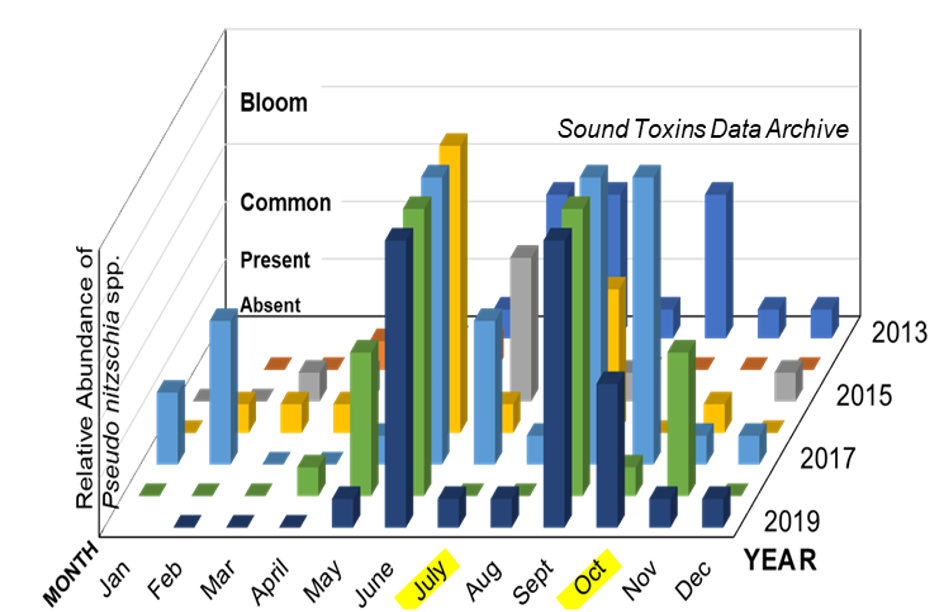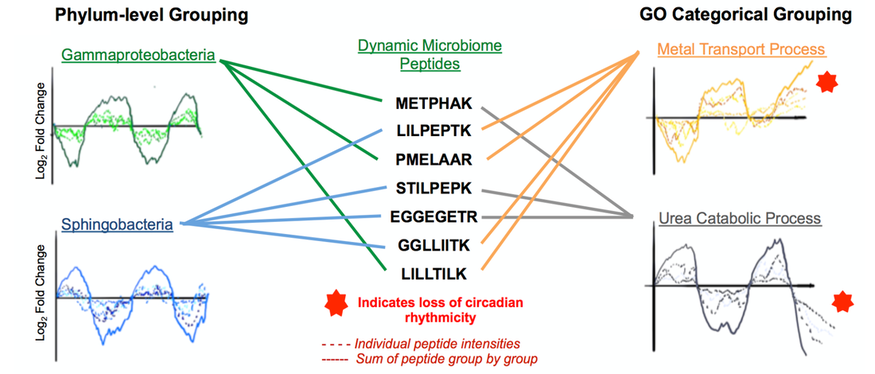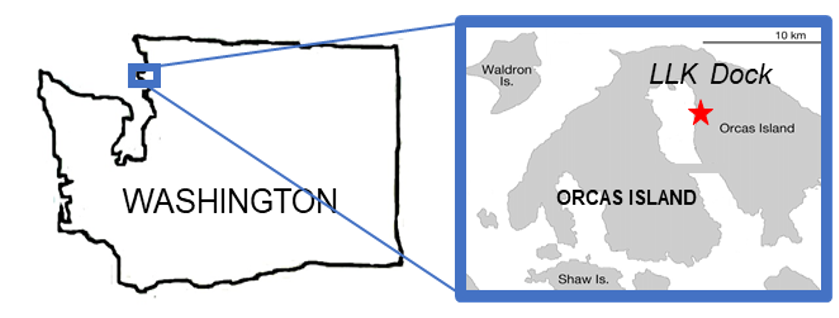Forecasting harmful algal blooms (HABs) using marine microbiomes
|
Harmful algal blooms (HABs) are a reoccurring toxic event threatening public health through the contamination of water quality worldwide. Various toxic phytoplankton species regularly undergo bloom events in both coastal and inland water bodies, wreaking havoc for water treatment facilities, fishing, and recreational industries, amassing ~$11 billion annually in healthcare costs related to human exposure. As changes in climate and agriculture continue to alter water chemistry, bloom events have been observed to occur more frequently, last longer, and release a wider range of toxic chemicals. The known HAB-forming phytoplankton Pseudo-nitzschia has been observed to forms blooms biannually in Puget Sound, WA.
Currently, there exists no method for predicting bloom onset, leaving the public vulnerable to a spectrum of potentially avoidable harmful toxins. |
Bacteria have been shown to respond to the photosynthetic circadian rhythm of the algae, mimicking circadian patterns in the expression of metabolically necessary proteins. A significant change in the ecosystem is likely to cause reactionary changes in patterns of protein expression, detectable as either individual peptides or peptide-groups sharing similar taxonomic origin or functional category. If the established circadian rhythmicity of a peptide or group of peptides is lost >24 hours prior to HAB initiation, it could be used as an indicator to predict impending bloom toxicity.
|
We plan to conduct high-resolution sampling of a local Pseudo-nitzschia spp. phytoplankton microbiome prior to a predicted bloom event and sampling until HAB-toxins peak. Microbiome samples will be analyzed using quantitative data-independent acquisition mass spectrometry methods to establish time-dependent peptide abundances. These peptides will be grouped and annotated into all potential taxonomic and functional groups using MetaGOmics and time-course data will be analyzed using Rhythmicity Analysis Incorporating Non-parametric methods. Peptides or peptide groups exhibiting significant changes in or loss of rhythmicity prior to bloom onset represent potential biomarkers for the future development of a rapid molecular peptide-based assay or probe for predicting HAB events.
|
Time lapsed Videos of our Field work at Orcas Island reveal the dedicated nature of our team!
|
|
In August of 2022 we went to Orcas Island and collected the microbiome from Eastsound waters every 4 hours for 30 days. To complete this, 2 teams of 2 women worked 12 hour shifts to cover the 24 hours. The video to the left features Brook Nunn (PI) and Scout Noble (high school intern) at the 4AM shift. Each timepoint collection took 4 hours and included cleaning, followed by pumping > 150 L of water to the lab and filtering the water for microbiome and phytoplankton fractions for the downstream analysis of metaproteomics, metatranscriptomics, metagenomics, and metabolomics. |
|
On the right is another timelapsed video taken by PhD Student Miranda Mudge! This provides the viewer of the birds-eye-view of the filtration rig and the samples collected over a 4 hour timepoint. Miranda led the nightshift over the 2 field seasons we ran. As a night-owl, operating from 1pm- 4am was a breeze. Ask her!
|
|
|
|
On the left is a time lapsed video of the Nunn Orcas Island 2022 team building the research station from a Fish-prep shed at Long Live the Kings Hatcher (THANK YOU MIKE O'CONNEL and BRUCE). The video is actually taken 5 days after we built it. Rain was on the way so we had to install the top portion to seal it from rain entering our lab. Everything was enginered with great precision (not a joke) to make sure the lab would hold over the 30 day field collection timeperiod. Rmember- we were living and working in that shed 24 hours a day for 30 days! It had to be clean so we could do molecular level analyses. In the video you will see Brook Nunn, Scout Noble, Gabi Cheblis, Miranda Mudge and Rachel Schauer.
|


